- GCN/BACODINE POSITION NOTICE
TITLE: GCN/SWIFT NOTICE
NOTICE_DATE: Tue 21 May 13 22:49:38 UT
NOTICE_TYPE: Swift-BAT GRB Position
TRIGGER_NUM: 556344, Seg_Num: 0
GRB_RA: 87.559d {+05h 50m 14s} (J2000),
87.750d {+05h 51m 00s} (current),
86.847d {+05h 47m 23s} (1950)
GRB_DEC: +14.452d {+14d 27' 09"} (J2000),
+14.455d {+14d 27' 20"} (current),
+14.439d {+14d 26' 20"} (1950)
GRB_ERROR: 3.00 [arcmin radius, statistical only]
GRB_INTEN: 4316 [cnts] Image_Peak=304 [image_cnts]
TRIGGER_DUR: 1.024 [sec]
TRIGGER_INDEX: 139 E_range: 15-50 keV
BKG_INTEN: 22955 [cnts]
BKG_TIME: 82141.41 SOD {22:49:01.41} UT
BKG_DUR: 8 [sec]
GRB_DATE: 16433 TJD; 141 DOY; 13/05/21
GRB_TIME: 82156.77 SOD {22:49:16.77} UT
GRB_PHI: -82.70 [deg]
GRB_THETA: 22.95 [deg]
SOLN_STATUS: 0x2003
RATE_SIGNIF: 24.51 [sigma]
IMAGE_SIGNIF: 12.11 [sigma]
MERIT_PARAMS: +1 +0 +0 +0 +1 +1 -100 +1 -88 +0
SUN_POSTN: 58.89d {+03h 55m 35s} +20.36d {+20d 21' 49"}
SUN_DIST: 28.12 [deg] Sun_angle= -1.9 [hr] (East of Sun)
MOON_POSTN: 194.66d {+12h 58m 38s} -9.03d {-09d 01' 41"}
MOON_DIST: 108.50 [deg]
MOON_ILLUM: 86 [%]
GAL_COORDS: 193.00, -6.52 [deg] galactic lon,lat of the burst (or transient)
ECL_COORDS: 87.61, -8.97 [deg] ecliptic lon,lat of the burst (or transient)
COMMENTS: SWIFT-BAT GRB Coordinates.
COMMENTS: This is a rate trigger.
COMMENTS: A point_source was found.
COMMENTS: This does not match any source in the on-board catalog.
COMMENTS: This does not match any source in the ground catalog.
COMMENTS: There is a bright star (mag=5.52) 9.50 arcmin from this position.
COMMENTS: This is a GRB.
COMMENTS: This trigger occurred at longitude,latitude = 209.35,9.39 [deg].
- red DSS finding chart
ps-file
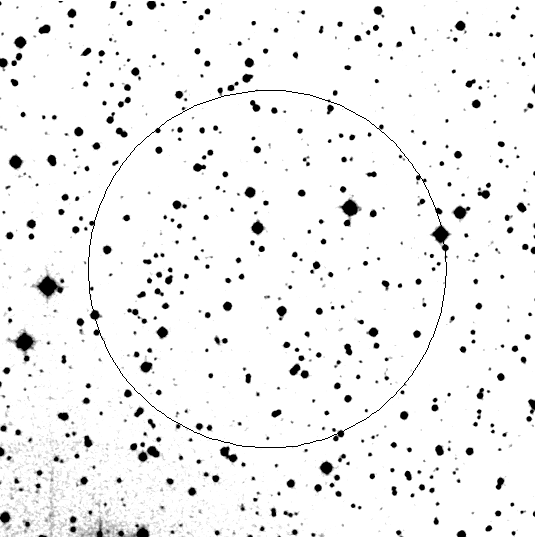
- GCN NOTICE
TITLE: GCN/SWIFT NOTICE
NOTICE_DATE: Tue 21 May 13 22:53:18 UT
NOTICE_TYPE: Swift-BAT GRB Lightcurve
TRIGGER_NUM: 556344, Seg_Num: 0
GRB_RA: 87.559d {+05h 50m 14s} (J2000),
87.750d {+05h 51m 00s} (current),
86.847d {+05h 47m 23s} (1950)
GRB_DEC: +14.452d {+14d 27' 09"} (J2000),
+14.455d {+14d 27' 20"} (current),
+14.439d {+14d 26' 20"} (1950)
GRB_DATE: 16433 TJD; 141 DOY; 13/05/21
GRB_TIME: 82156.77 SOD {22:49:16.77} UT
TRIGGER_INDEX: 139
GRB_PHI: -82.70 [deg]
GRB_THETA: 22.95 [deg]
DELTA_TIME: 64.00 [sec]
TRIGGER_DUR: 1.024 [sec]
SOLN_STATUS: 0x2003
RATE_SIGNIF: 24.51 [sigma]
IMAGE_SIGNIF: 12.11 [sigma]
LC_URL: sw00556344000msb.lc
SUN_POSTN: 58.90d {+03h 55m 35s} +20.36d {+20d 21' 51"}
SUN_DIST: 28.12 [deg] Sun_angle= -1.9 [hr] (East of Sun)
MOON_POSTN: 194.69d {+12h 58m 46s} -9.04d {-09d 02' 21"}
MOON_DIST: 108.54 [deg]
MOON_ILLUM: 86 [%]
GAL_COORDS: 193.00, -6.52 [deg] galactic lon,lat of the burst (or transient)
ECL_COORDS: 87.61, -8.97 [deg] ecliptic lon,lat of the burst (or transient)
COMMENTS: SWIFT-BAT GRB Lightcurve.
COMMENTS:
COMMENTS: The next comments were copied from the BAT_POS Notice:
COMMENTS: This is a rate trigger.
COMMENTS: A point_source was found.
COMMENTS: This does not match any source in the on-board catalog.
COMMENTS: This does not match any source in the ground catalog.
COMMENTS: There is a bright star (mag=5.52) 9.50 arcmin from this position.
COMMENTS: This is a GRB.
COMMENTS: This trigger occurred at longitude,latitude = 209.35,9.39 [deg].
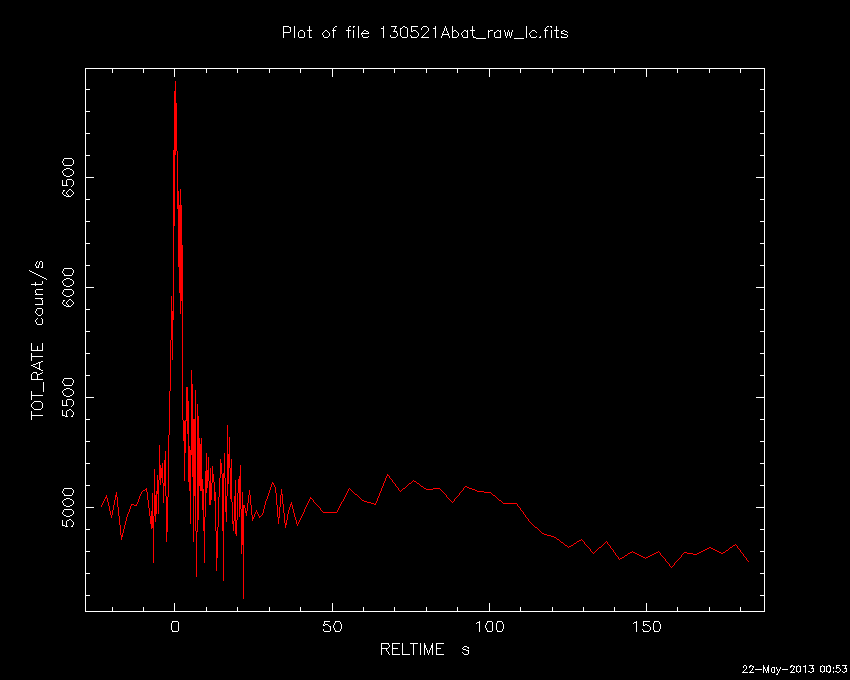
- GCN Circular #14691
C. Pagani (U Leicester), N. Gehrels (NASA/GSFC),
H. A. Krimm (CRESST/GSFC/USRA), C. J. Mountford (U Leicester),
K. L. Page (U Leicester), D. M. Palmer (LANL), T. Sakamoto (AGU) and
M. H. Siegel (PSU) report on behalf of the Swift Team:
At 22:49:16 UT, the Swift Burst Alert Telescope (BAT) triggered and
located GRB 130521A (trigger=556344). Swift could not slew to the
burst due to the Sun constraint. The BAT on-board calculated location is
RA, Dec 87.559, +14.452 which is
RA(J2000) = 05h 50m 14s
Dec(J2000) = +14d 27' 09"
with an uncertainty of 3 arcmin (radius, 90% containment, including
systematic uncertainty). The BAT light curve showed a single peak
structure with a duration of about 6 sec. The peak count rate
was ~2000 counts/sec (15-350 keV), at ~0 sec after the trigger.
Due to a Sun observing constraint, Swift cannot slew to the BAT
position until 05:50 UT on 2013 August 06. There will thus be no XRT or
UVOT data for this trigger before this time.
Burst Advocate for this burst is C. Pagani (cp232 AT star.le.ac.uk).
Please contact the BA by email if you require additional information
regarding Swift followup of this burst. In extremely urgent cases, after
trying the Burst Advocate, you can contact the Swift PI by phone (see
Swift TOO web site for information: http://www.swift.psu.edu/too.html.)
- GCN Circular #14692
Klotz A. (IRAP-CNRS-OMP), Gendre B. (IRAP-CNRS-OMP),
Boer M., Siellez K., Dereli H., Bardho O. (UNS-CNRS-OCA),
Atteia J.L. (IRAP-CNRS-OMP) report:
We imaged the field of GRB 130521A detected by SWIFT
(trigger 556344) with the TAROT robotic telescope (D=25cm)
located at the European Southern Observatory,
La Silla observatory, Chile.
The observations started 33.0s after the GRB trigger
(13.7s after the notice). The elevation of the field decreased from
14 degrees above horizon and weather conditions
were good but the event occured during the dusk
at 28 degrees from the Sun. Due to the twilight the
first image of 60s is saturated.
The second image is 30.0s exposure in tracking mode.
We do not detect any OT in the Swift BAT error box
with a limiting magnitude of:
t0+106.3s to t0+136.3s : Rlim = 15.5
We co-added a series of exposures:
t0+106.3s to t0+1795s : Rlim = 17.3
Magnitudes were estimated with the nearby USNO-B1 stars
and are not corrected for galactic dust extinction.
N.B. Galactic coordinates are lon=193.0037 lat= -6.5236
and the galactic extinction in R band is about 1.6 magnitude
estimated from D. Schlegel et al. 1998ApJ...500..525S.
This message may be cited.
- GCN Circular #14693
S. D. Barthelmy (GSFC), W. H. Baumgartner (GSFC/UMBC),
J. R. Cummings (GSFC/UMBC), N. Gehrels (GSFC), H. A. Krimm (GSFC/USRA),
A. Y. Lien (NASA/GSFC/ORAU), C. B. Markwardt (GSFC), C. Pagani (U Leicester),
D. M. Palmer (LANL), T. Sakamoto (AGU), M. Stamatikos (OSU),
T. N. Ukwatta (MSU) (i.e. the Swift-BAT team):
Using the data set from T-239 to T+963 sec from the recent telemetry downlink,
we report further analysis of BAT GRB 130521A (trigger #556344)
(Pagani, et al., GCN Circ. 14691). The BAT ground-calculated position is
RA, Dec = 87.568, 14.470 deg which is
RA(J2000) = 05h 50m 16.3s
Dec(J2000) = +14d 28' 10.8"
with an uncertainty of 1.6 arcmin, (radius, sys+stat, 90% containment).
The partial coding was 67%.
The mask-weighted light curve shows a single peak starting at T-2 sec, peaking
at T+0 sec and falling to near background by T+4 sec, followed by a weak tail
out to approximately T+12 sec. At around T+120 sec, the source moved out of the
field of view due to a pre-planned slew to another target. T90 (15-350 keV) is
11.0 +- 2.4 sec (estimated error including systematics).
The time-averaged spectrum from T-0.64 to T+12.64 sec is best fit by a simple
power-law model. The power law index of the time-averaged spectrum is
2.11 +- 0.20. The fluence in the 15-150 keV band is 4.2 +- 0.5 x 10^-07
erg/cm2. The 1-sec peak photon flux measured from T-0.14 sec in the 15-150 keV
band is 1.9 +- 0.2 ph/cm2/sec. All the quoted errors are at the 90% confidence
level.
The results of the batgrbproduct analysis are available at
http://gcn.gsfc.nasa.gov/notices_s/556344/BA/
- GCN Circular #14697
D. James, C. Foster, P. Taylor, M. Carroll, A. Trotter, D. Reichart, A.
LaCluyze, J. Haislip, T. Berger, H. T. Cromartie, R. Egger, A. Foster,
N. Frank, K. Ivarsen, M. Maples, J. Moore, M. Nysewander, E. Speckhard,
and J. A. Crain report
Skynet observed the Swift/BAT localization of GRB 130521A (Pagani et
al., GCN 14691, Swift trigger #556344) with four 16" telescopes of the
PROMPT array at CTIO, Chile. Starting at 2013-05-21, 22:49:16 UT and
continuing until 23:01:04 UT (t=49.2s-11.8m post-trigger), it took 66
exposures in the BVRI bands. We did not detect a fading afterglow within
the 3 arcmin radius of the Swift/BAT error circle, which was centered on
RA 05h50m14.2s, Dec +14d27m08.6s (J2000.0).
A plot of the 3-sigma limiting magnitudes in each exposure, calibrated
to six USNO-B1/NOMAD stars in the field, is here:
http://skynet.unc.edu/grb/grb130521a.png
We stacked all the images in each band and obtained 3-sigma limiting
magnitudes on any afterglow of:
Filter B V R I
Mag >18.29 >18.53 >18.13 >17.07
Magnitudes are Vega magnitudes, and have not been corrected for the
expected line-of-sight Milky Way dust extinction E(B-V)=0.38 (Schlegel
et al. 1998).
No further Skynet observations are scheduled.
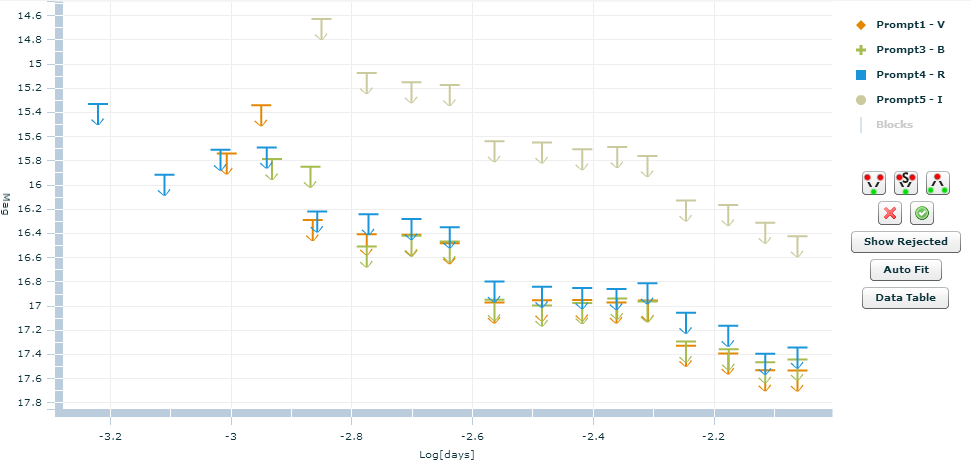
- GCN Circular #14713
FROM: Adam S. Trotter at UNC-Chapel Hill/PROMPT/Skynet
D. James, C. Foster, P. Taylor, M. Carroll, A. Trotter, D. Reichart, A.=20
LaCluyze, J. Haislip, T. Berger, H. T. Cromartie, R. Egger, A. Foster,=20
N. Frank, K. Ivarsen, M. Maples, J. Moore, M. Nysewander, E. Speckhard,=20
and J. A. Crain report
Skynet observed the Swift/BAT localization of GRB 130521A (Pagani et=20
al., GCN 14691, Swift trigger #556344) with four 16" telescopes of the=20
PROMPT array at CTIO, Chile. Starting at 2013-05-21, 22:49:16 UT and=20
continuing until 23:01:04 UT (t=3D49.2s-11.8m post-trigger), it took 66=20
exposures in the BVRI bands. The field was 28.5 degrees from the sun at=20
this time, so the duration of the observation was limited by sky=20
brightness and high airmass.
In James et al. (GCN 14697) we reported that we did not detect an=20
afterglow. We conducted follow-up observations two nights later, and on=20
reexamination discovered that an extremely red afterglow was in fact=20
detected in our first night=92s I and R band exposures.
The position of the afterglow is (J2000.0):
RA = 05h 50m 10.55s
Dec = 14d 27m 26.8s
A finder chart is at:
http://skynet.unc.edu/grb/grb130521a_finder.png
A preliminary light curve is at:
http://skynet.unc.edu/grb/grb130521a_2.png
Magnitudes are in the Vega system and are calibrated to 19 APASS stars=20
in the field. We regard the V band detection to be questionable, but the=20
R and I band detections are solid.
The galactic coordinates of the afterglow are l=3D193.3312, b=3D-5.9321. =
The=20
dust emission maps of Schlegel et al. (1998) indicate E(B-V)=3D0.381 alon=
g=20
this line of sight; the predicted extinction in each of the bands that=20
we observed is:
Filter B V R I
A_lambda 1.65 1.24 1.00 0.75
The observed R band brightness is 1.5 magnitudes fainter than in the I=20
band. Correcting for galactic dust extinction, the R band is still 1.25=20
magnitudes fainter than in the I band. Such an extremely red afterglow=20
could be due to an unusually large amount of dust extinction in the host=20
galaxy or to the burst being at a redshift z-5. Follow-up observations=20
are encouraged when the source is again visible in early August.
We encourage anyone who may have observed this field, particularly in=20
the near infrared, to reexamine their images to see if this afterglow=20
was detected in them.
No further Skynet observations are scheduled.
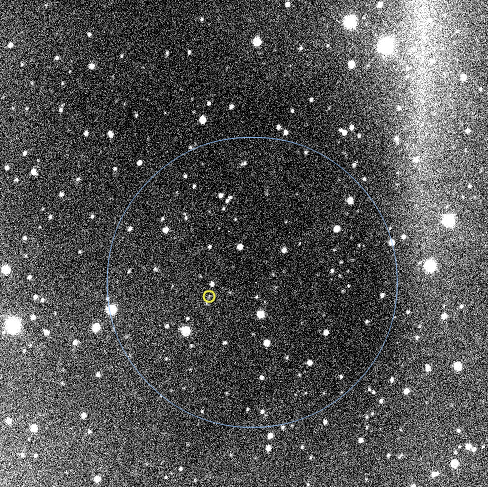
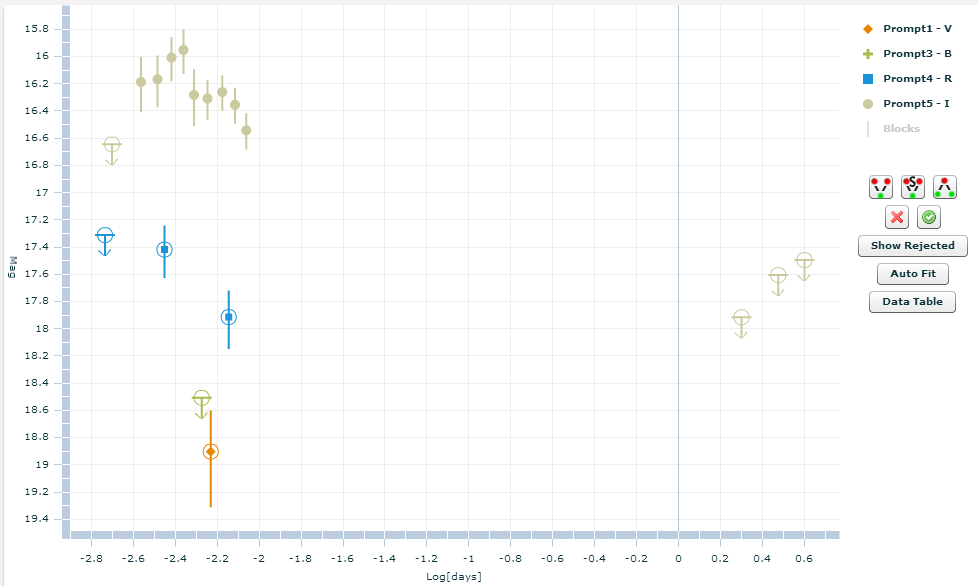
![]() Previous IAU Circulars
Previous IAU Circulars 



